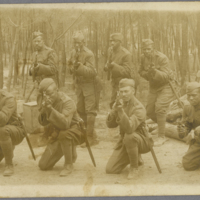Segregation in the military
Before the first training camp opened, African American men experienced resistance from military officials, commissioned white officers and white soldiers, all of whom regarded their presence as unsatisfactory and a threat to entrenched American race relations. Racist beliefs that black soldiers could not be depended on to serve with dignity and honor due to their so-called inherent weaknesses in character, mental capacity and moral turpitude shaped the experiences of all drafted and enlisted men. Adopting a policy of strict segregation to maintain and preserve discipline, the War Department organized separate units in direct response to the problems anticipated between white soldiers, who would not accept black soldiers as equals, and black soldiers, who would refuse to be intimidated by whites and their sense of entitlement. In the South especially, black troops were denied adequate medical treatment, clothing and housing. In some instances, shelter for African American troops “often consisted of tents without the flooring or boxing usually provided for whites housed under canvas, and sometimes without stoves in winter weather.”[1] Overpopulated barracks, the lack of proper sanitation facilities and infrequent medical attention quickly advanced the spread of preventable diseases.
Services of Supply
The health, morale and overall welfare of black troops mattered less to military officials, since most black soldiers were destined to serve in the rear as the muscle needed to supply America’s white soldiers on the field of battle with the necessary supplies, rather than as fighting troops.[2] Of the nearly four hundred thousand African American soldiers serving during the First World War, only 40,000 saw combat, while the majority served in the Services of Supply (SOS) regiments unloading ships, repairing battlefields, and building roads. These men represent the invisible labor that was nonetheless critical for the Allied victory. As early as June 1917, black labor battalions, or stevedores, were responsible for loading the hulls of cargo ships with supplies bound for France. Black stevedores had also arrived in the port cities of Brest, St. Nazaire and Bordeaux, where they unloaded ships laden with supplies for the front. These noncombatant soldiers were also responsible for road building, constructing ammunition dumps, cooking, building warehouses and salvaging materials from the theater of war. The assumed low status of black soldiers also made them vulnerable to ill-treatment by their white counterparts, many of whom asserted their sense of superiority in the belief that no black man had any rights that a white man was bound to respect. Even in France, white men accustomed to exercising their assumed dominance over blacks did so with impunity. In some instances, white soldiers and officers even participated in murdering black soldiers as a form of sport.[3]
On the Front Lines
With the support of Secretary of War Newton Baker, the all black 92nd and 93rd combat Divisions were formed and deployed to France. By mid-September 1918, the 368th Regiment of the 92nd Division, along with the 77th American Division and the French 4th Army, moved into position near the Argonne Forest in preparation for an offensive against the German army. Prior to this assault, the all-black regiment had had very little training in maneuvers under heavy shelling, lacked the proper equipment to cut through the thick entanglements, and were not supplied with the necessary “signal flares and grenade launchers.”[4] These factors made them ill-prepared to maintain their organizational effectiveness in combat. What’s more, the trust black soldiers had in their white commanding officers was continuing to erode as “many of the field officers seemed far more concerned with reminding their Negro subordinates that they were Negroes” than preparing them to execute the orders handed down from General Headquarters.[5] On 28 September, the 368th came under intense German fire, and in the confusion of combat several companies “withdrew in disorder,” choosing to retreat to the trenches in an effort to regroup.[6] Not only was the regiment accused of cowardice, but the accusation was extended to the entire 92nd Division.
Conversely, the most recognized and well-known black infantry regiment to serve during the First World War was the 369th of the 93rd Division. Historically known as the Harlem Hellfighters, the 369th was originally formed out of the 15th New York National Guard Regiment created in 1916. The regiment included men from all walks of life, including laborers, doctors, lawyers, hustlers, baseball players, educators and musicians. On 12 March 1918, the all-black regiment was assigned to the French army as replacement troops – one of four infantry regiments from the 93rd Division who served with the French for the duration of the war. It is here that the 369th made a name for itself. Serving at the front for 191 consecutive days, the Harlem Hellfighters defended not only the French lines against the German assault, but the honor and pride of all African Americans whose futures would be impacted by the outcome of the war as well. Indeed, the heroism of Private Henry Johnson, whose valiant efforts to save fellow soldier Needham Roberts from being captured by a German raiding party earned him the French Croix de Guerre, supported the notion that African American soldiers were not only brave, but were honorable and loyal too.
Discover the veterans buried in Oakland Cemetery
Footnotes:
[1] Arthur E. Barbeau and Florette Henri, The Unknown Soldiers: Black American Troops in World War I, (Philadelphia 1974): 51.
[2] Chad Williams, Torchbearers of Democracy: African American Soldiers in the World War I Era, (Chapel Hill 2010), 111.
[3] Williams, Torchbearers of Democracy, 113.
[4] Barbeau and Henri, The Unknown Soldiers, 150.
[5] Quoted in Richard Slotkin, Lost Battalions. The Great War and the Crisis of American Nationality (New York: Macmillan, 2005): 287.
[6] Ibid., 288.
Text adapted from:
McDaniels III, Pellom: African American Soldiers (USA) , in: 1914-1918-online. International Encyclopedia of the First World War, ed. by Ute Daniel, Peter Gatrell, Oliver Janz, Heather Jones, Jennifer Keene, Alan Kramer, and Bill Nasson, issued by Freie Universität Berlin, Berlin 2014-10-08. DOI: 10.15463/ie1418.10175.








